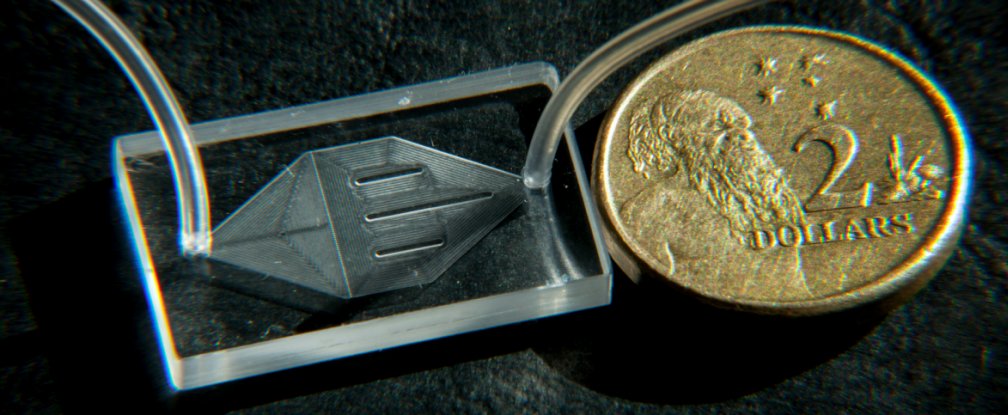
Pitch your Startup, App or Hardware or post a Startup Event or Startup Job
Ed: Very excited about this. This post was first published on sciencealert.com by Fiona MacDonald (thanks Fiona) however I felt compelled to share it as I have been mentoring Ryan for some time now and it looks like he is getting pretty close to putting his low cost Gene Therapy chips into lab trials.
It’s potentially a really big deal in delivering treatment for certain Cancers and HIV, he is currently self funding most of the costs personally and with small grants while completing his PhD, so he may be seeking Angel or VC funding later in the year assuming success in this next set of tests.
Image Credit: Warren McKenzie
The next generation of lab-on-a-chip devices could bring down the cost of gene therapy
A graduate student is developing a cost-effective new method of delivering desirable genes into human cells using a tiny plastic chip. The technique could substantially reduce the cost and extend the reach of new cancer-killing immunotherapy treatments, which currently rely on viral vectors and cost around $5,000-$10,000 a pop.
The patent-pending device, which is being developed by engineering PhD student Ryan Pawell from the University of New South Wales (UNSW) in Australia, contains tiny features less than 1/10th the width of a strand of human hair, which can deliver biological materials to cells. This allows the cells to be reprogrammed, and essentially recreates a fully functioning laboratory on a piece of plastic the size of a postage stamp.
“My overall goal is to use technology to reduce the cost of healthcare and to make it accessible to everyone, not just those who can afford it,” Pawell told ScienceAlert.
Lab-on-a-chip devices are already being used around the world to help provide on-the-spot diagnoses for diseases such as HIV and Ebola, but Pawell quickly realised that the potential for the technology was much broader.
“We worked out how to make these tiny devices out of plastic using a specific diagnostic design. But then we realised that we could essentially use any other design you wanted to give them different functions,” he said. “Now I’m trying to use the technology to deliver DNA to cells and reprogram them to have a therapeutic effect.”
This process could substantially bring down the cost of gene therapy, which is crucial in new medical treatments such as immunotherapy.
Immunotherapy involves extracting a person’s own immune cells and turning on genes inside them to activate them against certain tumours or diseases, before then inserting these cells back into the patient.
Because the treatment uses a patient’s own cells, it has far fewer side effects than traditional therapies, and early trials show that they may also be far more effective – with studies so far proving immunotherapy is successful against aggressive forms of melanoma and glioblastoma.
But the problem is, in order to turn on genes against the desired disease, scientists need to deliver DNA into the patient’s cells, and right now our best way of doing this is to use viral vectors, which are expensive, time-consuming and often unreliable. Pawell estimates that immunotherapy treatments can cost around $5,000 to $10,000, but by tweaking his the lab-on-a-chip technology, he predicts he’ll be able to do the same thing for a substantially reduced cost.
Importantly the technology could also help to treat significantly more people. Manufacturing these therapies by viral vectors requires industrial-sized manufacturing plants and costs tens of millions of dollars – but it only enables the treatment of thousands of patients per year. However, these microfluidic devices can be manufactured at scales of more than a million devices per year.
It’s still early days, and Pawell is currently validating that his chips can accurately and safely deliver DNA into human cells, but as the platform is already proven and tested in the field, once they’ve done this, it should be rapidly scalable.
Even better, they’ve also been able to show that the therapeutic cells their lab-on-a-chip creates are highly viable, which means they’re able to replicate and survive on their own after they’ve had the new DNA inserted.
“Regulators like to see viability rates of 80 percent or higher, we’ve achieved 97 percent in a cell model,” said Pawell, who was invited to present the work at the AUS-USA Technical Exchange Meeting is Washington DC earlier this year.
There’s still a long way to go before these cells are trialled in humans, but we’re pretty excited to see what happens next.
And in the meantime, find out more about the technique behind Pawell’s lab-on-a-chip device in this UNSW video from last year:
Pitch your Startup, App or Hardware or post a Startup Event or Startup Job